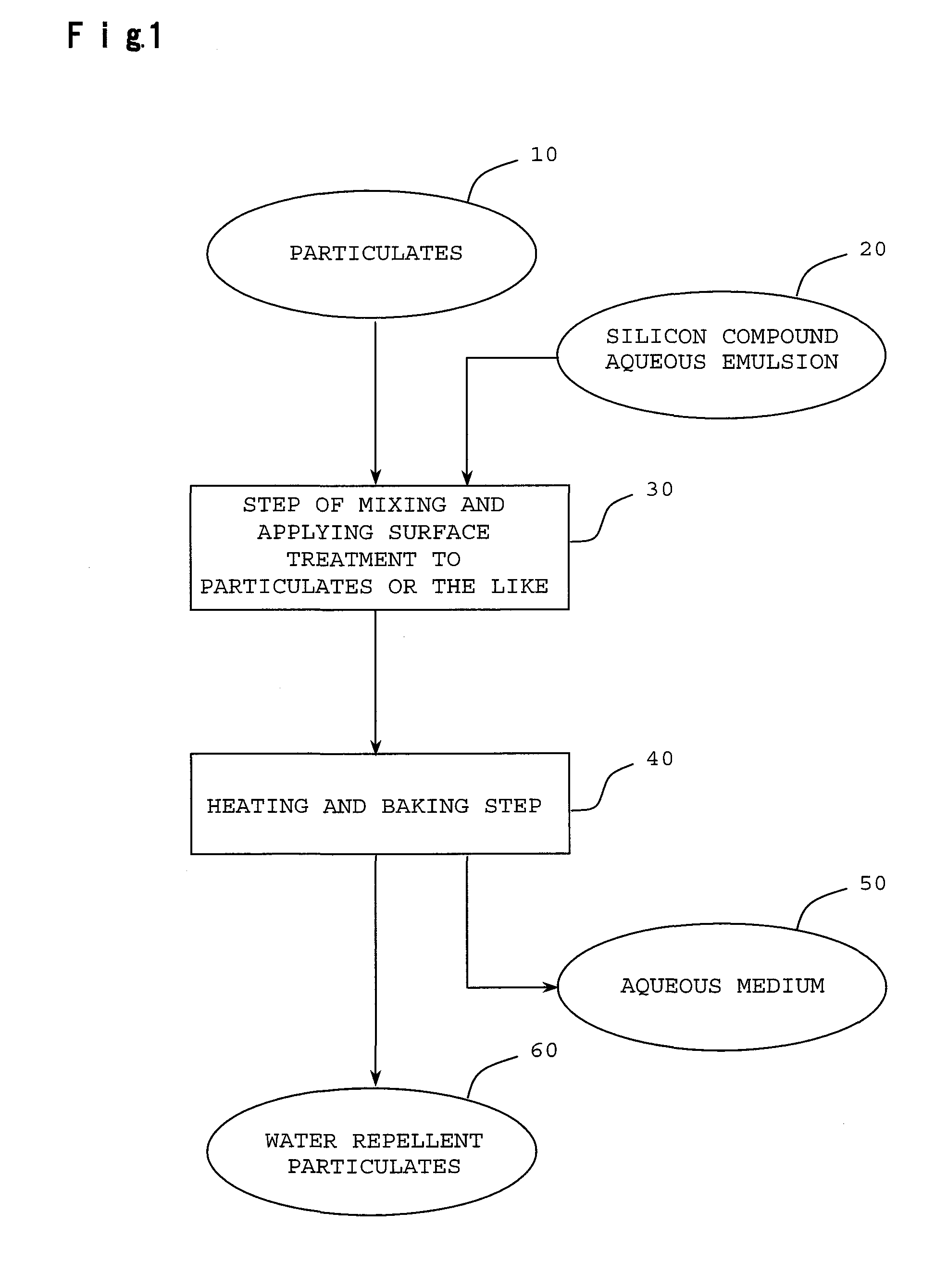Process for producing water repellent particulates
- Summary
- Abstract
- Description
- Claims
- Application Information
AI Technical Summary
Benefits of technology
Problems solved by technology
Method used
Image
Examples
example 1
[0096](1) As an inorganic powder to be surface treated, 30 g of spherical silica gel (average particle size: δ 1 μm, specific surface area: 119 m2 / g, pore volume: 0.50 ml / g) was used. Further, as an aqueous emulsion of a silicon compound, 1.5 g of an aqueous emulsion of methyl hydrogen silicone oil (manufactured by Shin-Etsu Chemical Co., Ltd., tradename: Polon-MR) was preliminarily diluted with 14.4 mL of deionized water. The ratio of silica gel:silicone oil emulsion (as calculated as silicone oil pure solid)=100:3.
[0097](2) The inorganic powder was put in a polyethylene container having a capacity of 1,000 mL, and the container was set to TURBULA shaker mixer (manufactured by SHINMARU ENTERPRISES CORPORATION) as a powder mixer. While the silicone oil emulsion was dividedly added, the is powder was well mixed in a powder state for 30 minutes to apply surface treatment.
[0098](3) The surface treated powder mixture was heated at 180° C. for drying for 6 hours, thereby to obtain desire...
example 2
[0099](1) As an inorganic powder to be surface treated, 30 g of spherical silica gel (average particle size: 5 μm, specific surface area: 756 m2 / g, pore volume: 0.88 ml / g) was used. Further, as an aqueous emulsion of a silicon compound, 2.5 g of an aqueous emulsion of methyl hydrogen silicone oil (manufactured by Shin-Etsu Chemical Co., Ltd., tradename: Polon-MR) was preliminarily diluted with 25.4 mL of deionized water. The ratio of silica gel:silicone oil emulsion (as calculated as silicone oil pure solid)=100:5.
[0100](2) The inorganic powder was put in a polyethylene container having a capacity of 1,000 mL in the same manner as in Example 1, and the container was set to TURBULA shaker mixer (manufactured by SHINMARU ENTERPRISES CORPORATION) as a powder mixer. While the silicone oil emulsion was dividedly added, the powder was well mixed in a powder state for 30 minutes to apply surface treatment.
[0101](3) The surface treated powder mixture was heated at 180° C. for drying for 6 h...
example 3
[0102](1) As an inorganic powder to be surface treated, 30 g of spherical silica gel (average particle size: 5 μm, specific surface area: 756 m2 / g, pore volume: 0.88 ml / g) was used. Further, as an aqueous emulsion of a silicon compound, 7.5 g of an aqueous emulsion of amino-modified silicone oil (manufactured by Shin-Etsu Chemical Co., Ltd., tradename: X-52-2265, silicone oil component: 40%) was preliminarily diluted with 18.9 mL of deionized water. The ratio of silica gel:silicone oil emulsion (as calculated as silicone oil pure solid)=100:10.
[0103](2) The inorganic powder was put in a polyethylene container having a capacity of 1,000 mL in the same manner as in Example 1, and the container was set to TURBULA shaker mixer (manufactured by SHINMARU ENTERPRISES CORPORATION) as a powder mixer. While the silicone oil emulsion was dividedly added, the powder was well mixed in a powder state for 30 minutes to apply surface treatment.
[0104](3) The surface treated powder mixture was heated...
PUM
 Login to View More
Login to View More Abstract
Description
Claims
Application Information
 Login to View More
Login to View More - R&D
- Intellectual Property
- Life Sciences
- Materials
- Tech Scout
- Unparalleled Data Quality
- Higher Quality Content
- 60% Fewer Hallucinations
Browse by: Latest US Patents, China's latest patents, Technical Efficacy Thesaurus, Application Domain, Technology Topic, Popular Technical Reports.
© 2025 PatSnap. All rights reserved.Legal|Privacy policy|Modern Slavery Act Transparency Statement|Sitemap|About US| Contact US: help@patsnap.com



